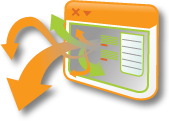
I work for a professional services firm. I am currently involved in an effort to re-engineer our practice-facing technology and processes in order to make our consultants more efficient at execution, more effective at collaboration, and generally more satisfied on and off the job. In short, it is a huge effort to make the firm more usable for its employees.
It’s actually pretty exciting to be a part of, since I can see it start to finish as an experience design effort. We are tasked with making the firm more useful, usable, and compelling. The frustration sets in because the team at-large does not think in these terms. They come from more traditional strategy and architecture backgrounds where the philosophy is find pain points and patch them. I am concerned that this approach will only bring us to parity, at best.
There is a contingent (mostly the very tech-savvy) who seem to think we should be implementing the latest, greatest, Web 2.0-iest solutions without regard to how they mesh with the way our resources operate. This is the “Field of Dreams” method of technology portfolio management – build it and they will come. This other extreme would put us out front of other firms as far as the technology we utilize, but there is great risk it would be under-utilized or, worse, create a whole new set of pain points.
What still needs to happen is a functional decomposition of the way our people work. We need to create a model which captures the basic processes that make up the work-life of a consultant and improvements need to be suggested in a testable way. Once we understand that, we could explore a technology solution which would support the improved model. Our resources are knowledge workers in the deepest sense of the word and only now, after six months, is the question “how does information move throughout our firm” being asked.
I’m sure we will arrive at the correct answer, but not without patching some pain points of our own. I’ll keep you posted.

